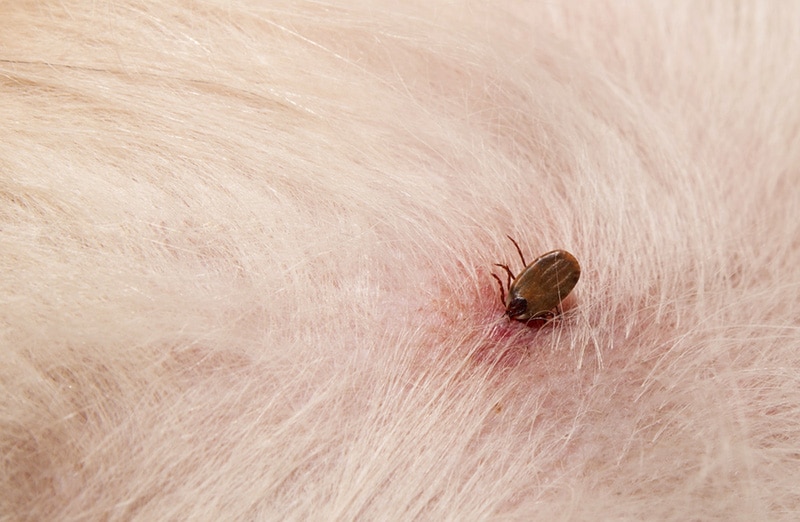
Rocky Mountain Spotted Fever (RMSF) is a bacterial disease that can be transmitted by ticks to your dog 1. This disease can be found in North, South, and Central America. Knowing your dog may have RMSF can be difficult as the abnormal signs can be confused with a number of diseases. In this article we will discuss in more detail how your dog may get RMSF, what the signs of the disease are, and how it can be treated. Prevention is also key with Rocky Mountain Spotted Fever, and there are some great options available for your dog.
What Is Rocky Mountain Spotted Fever?
Rocky Mountain Spotted Fever is a bacterial disease that is transmitted by ticks. RMSF is caused by an infection with the bacteria Rickettsia rickettsia. The bacteria will infect certain species of ticks, which can then bite your dog. As the tick enjoys a tasty meal of your dog’s blood, the bacteria are transmitted into your dog’s blood stream. The tick needs to be attached for at least 4-6 hours in order to pass on the bacteria. Therefore, having your dog on tick prevention will help keep the tick from being attached long enough to transmit the disease.
Most commonly, RMSF is spread by the Rocky Mountain Wood Tick in the western United States, the American Dog Tick in the midwestern and eastern United States, and less commonly, the brown dog tick or the Lone Star tick in the southwestern United States and Mexico. There are other ticks that can pass the disease, but these are the most commonly reported. The name of the disease can be deceiving as only a low percentage of cases are actually reported from the Rocky Mountain Region. Most commonly, the disease is diagnosed in the warmer months across the country: April through September. However, depending on the area of the country, RMSF can be found year-round.


What Are the Signs of Rocky Mountain Spotted Fever?
The signs of a RMSF infection can be very vague. Commonly your dog may have a high fever, be lethargic, have a decreased appetite, or even be completely anorexic. Some dogs may develop a rash, swelling of one or multiple limbs or other body parts, vomiting, and diarrhea.
A fever may develop within a week of the infected tick bite and last for up to 2 weeks. This is important to remember so you can let your veterinarian know if your dog was in an area with a high tick population within a week or two of becoming sick. The disease can cause a decrease in the number of red blood cells and platelets, potentially leading to pale gums and spontaneous bleeding. In severe cases, your dog may become severely lethargic, have an increase in their respiratory rate, collapse, or start to have bloody urine or feces, or even cough up or vomit blood.
What Are the Causes of Rocky Mountain Spotted Fever in a Dog?
Rocky Mountain Spotted Fever is caused by an infection with the Rickettsia rickettsia bacterium. Ticks are considered a vector. In other words, the tick will have a blood meal on an animal and have the bacteria enter their bloodstream. The bacterium then replicates, and the tick can bite another animal, passing it along to that new host. RMSF is one of many Rickettsial infections. Many of the other Rickettsial infections are also passed along to dogs, and even humans, by infected ticks.


How Do I Care for a Dog With Rocky Mountain Spotted Fever?
Your dog will need to be treated with a long, aggressive course of antibiotics to clear the bacterial disease. No amount of home remedies, herbs, and oils will clear the responsible bacteria aside from an antibiotic. Doxycycline is the most commonly used antibiotic. However, your veterinarian may prescribe a different medication if your dog has an adverse reaction to the medication. Most commonly we will see vomiting and/or diarrhea from doxycycline.
Prevention is your best defense against not only Rocky Mountain Spotted Fever, but other tick diseases as well. There are many good products on the market today that help prevent both flea and tick infestations. Topical products, or products that are applied to the skin of your dog, are typically not as effective as oral products. Your dog’s lifestyle – i.e., if you go hiking with them, camping, what your yard is like, and/or if they just live in an apartment and take walks around the neighborhood – will help your veterinarian prescribe the most appropriate preventative for your dog.
Unfortunately, a lot of the prescription flea and tick preventatives on the market have gotten bad media about rare side effects. Over the counter products, or home remedies such as essential oils, are not only ineffective but can also cause damage. Always speak to your veterinarian about the risks of preventatives and to help you navigate what is best for your dog. If you find any ticks on your dog, you can also remove them yourself. Just make sure that you kill the tick so that it cannot bite you.


Frequently Asked Questions
How Is Rocky Mountain Spotted Fever Diagnosed?
As discussed, the signs of RMSF are non-specific. In other words, other diseases share the same abnormal signs. Your veterinarian will likely perform a CBC and chemistry test to look for decreased red blood cells and platelet numbers. Specialized blood testing to a lab can then further narrow down the diagnosis of RMSF.
Can I Catch RMSF From My Dog?
If your dog has been diagnosed with, and/or infected with RMSF, your dog cannot pass it to you per se. In other words, your dog can’t pass the bacteria to you by licking and/or biting you. However, if the infected tick bites your dog and is in the vicinity, it can then also bite you, infecting you.
Can Rocky Mountain Spotted Fever Be Cured?
Yes. The antibiotic doxycycline is the recommended treatment for dogs with RMSF. However, if left undiagnosed and untreated, your dog can develop severe complications and can die from the disease.
Conclusion
Rocky Mountain Spotted Fever is caused by infection from the bacterium Rickettsia rickettsia. Multiple species of ticks act as a vector to transmit the bacteria from one infected animal to another. People can also develop RMSF after being bit by an infected tick. Your dog may have vague signs of lethargy, anorexia, a rash, and bloodwork abnormalities. Your veterinarian will likely start treatment with an antibiotic for RMSF while awaiting specialized blood tests from the lab. If detected and treated early, your dog can recover from RMSF. A prescription preventative from your veterinarian is your best defense against Rocky Mountain Spotted Fever.
Featured Image Credit: Natalya Erofeeva, Shutterstock







